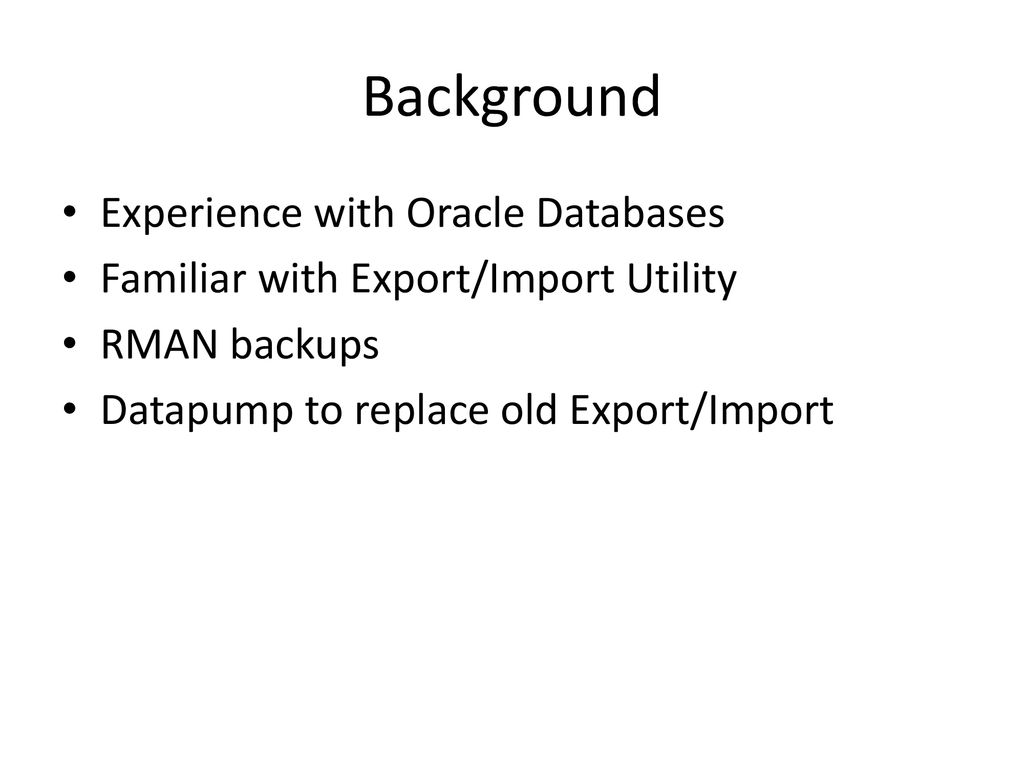

The server for that request contacts the remote source database referenced by the database link in the NETWORK_LINK parameter, retrieves the data, and writes it directly back to the local database. This means that the impdp client initiates the import request. The NETWORK_LINK parameter initiates a network import.

The local Import client connects to the database instance identified by the connect descriptor inst1 (a simple net service name, usually defined in a tnsnames.ora file), to import the data on that instance.ĭo not confuse invoking the Import utility using a connect identifier with an import operation specifying the Import NETWORK_LINK command-line parameter. > impdp inst1 DIRECTORY=dpump_dir DUMPFILE=hr.dmp TABLES=employees The following example invokes Import for user hr, using the connect descriptor named inst1: This requires an active listener (to start the listener, enter lsnrctl start) that can be located using the connect descriptor. The connect identifier can be an Oracle*Net connect descriptor or a name that maps to a connect descriptor. This identifier can specify a database instance that is different from the current instance identified by the current Oracle System ID (SID). You can specify a connect identifier in the connect string when you invoke the Data Pump Import utility. Interactive-command mode is also enabled when you attach to an executing or stopped job.įor a complete description of the commands available in interactive-command mode, see Commands Available in Import's Interactive-Command Mode. This mode is enabled by pressing Ctrl+C during an import operation started with the command-line interface or the parameter file interface. Interactive-Command Interface: Stops logging to the terminal and displays the Import prompt, from which you can enter various commands, some of which are specific to interactive-command mode. See Use of Quotation Marks On the Data Pump Command Line. The use of parameter files is recommended if you are using parameters whose values require quotation marks. The only exception is the PARFILE parameter because parameter files cannot be nested. Parameter File Interface: Enables you to specify command-line parameters in a parameter file. For a complete description of the parameters available in the command-line interface, see Parameters Available in Import's Command-Line Mode. You can interact with Data Pump Import by using a command line, a parameter file, or an interactive-command mode.Ĭommand-Line Interface: Enables you to specify the Import parameters directly on the command line. To see some examples of the various ways in which you can use Import, refer to Examples of Using Data Pump Import. This is done using data filters and metadata filters, which are implemented through Import commands. This is known as a network import.ĭata Pump Import enables you to specify whether a job should move a subset of the data and metadata from the dump file set or the source database (in the case of a network import), as determined by the import mode. This allows export and import operations to run concurrently, minimizing total elapsed time. Import can also be used to load a target database directly from a source database with no intervening dump files. During an import operation, the Data Pump Import utility uses these files to locate each database object in the dump file set.

The files are written in a proprietary, binary format.

The dump file set is made up of one or more disk files that contain table data, database object metadata, and control information. See Chapter 19, "Original Export and Import" for a description of the original Import utility.ĭata Pump Import (hereinafter referred to as Import for ease of reading) is a utility for loading an export dump file set into a target system. Although its functionality and its parameters are similar to those of the original Import utility ( imp), they are completely separate utilities and their files are not compatible. Data Pump Import (invoked with the impdp command) is a new utility as of Oracle Database 10 g.


 0 kommentar(er)
0 kommentar(er)
